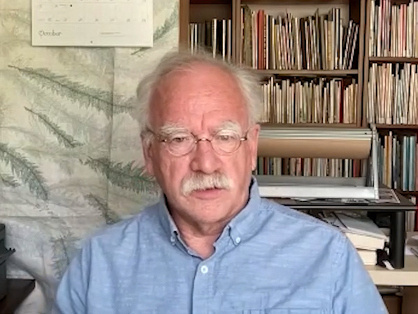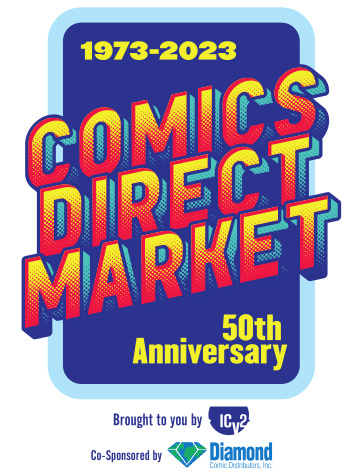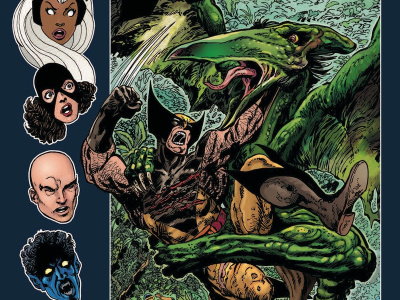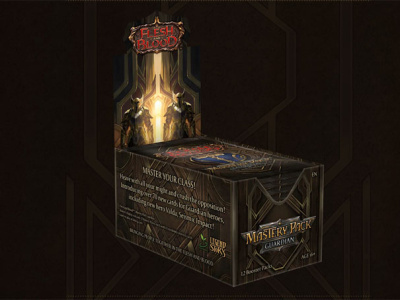For his article on direct market pioneer Bud Plant (see "Bud Plant, a Pioneer"), Dan Gearino (author of The Comic Shop, see "New Edition of ‘Comic Shop’") conducted a meaty video interview with Plant, which you can watch in three parts:
Bud Plant Video Interview, Part 1
Bud Plant Video Interview, Part 2
Bud Plant Video Interview, Part 3
We are also making available full transcripts of the interview, in three parts corresponding to the three parts of the video interview. In Part 1, Plant talks about the very early days of the comics business in the 1960s, and some of the first comic stores in California. In Part 2, he talks about meeting Phil Seuling, the beginnings of the direct market, and opening the first Comics & Comix store. In Part 3, he talks about rapid growth in the 1980s, selling his wholesale business to Diamond, and the meaning of it all.
This interview and article are part of ICv2’s Comics Direct Market 50th Anniversary celebration; for more, see “Comics Direct Market 50th Anniversary.”
I'm Dan Gearino and I am here with Bud Plant, who has been a retailer, a distributor (is still a retailer), and pretty much covers the whole history of the direct market and comics, even the pre‑history, a lot of the pre‑history. Bud, it's great to see you.
Hey, thanks. Pre‑history, huh? I have to make a note of that one.
Yeah. Pre‑history.
Pre‑history is pre Phil Seuling, I guess, something like that.
You could go way back with pre‑history, but I wanted to maybe start with some of that pre‑history, which is: comics people and other comics fans became the kind of people you were hanging out with at a young age. Just walk me through where was that, and what was that group like.
We called that the San Jose group because there was a bunch of us that just happened to be, luckily, kids in San Jose and basically in high school, where we all started coming together. San Jose is a fairly big town, and I was actually 18 miles away from John Barrett and Jim Buser and most of the other guys, they all lived on the west side of town, but we started running into each other. I think I met Michelle Nolan when I was 13 or 14; we’d bump into each other at the flea market, too. Anyway, we got to know each other. These guys had already discovered the Rocket’s Blast [Comicollector fanzine] and introduced me to fandom actually. Jim Buser had been around and writing letters to companies and getting the Rocket’s Blast actually for quite a while although he was only my age. He just started a little earlier.
So anyway, there was a whole group, Michelle Nolan, Tom Tallmon, Rudy Franke, who published Voice of Comicdom, Dennis Cunningham, who published Weirdom and the very first [Richard] Corben material, Tales from the Plague was one of Corben’s very first things and that came out of fandom. There's a whole group of folks down there in the South Bay basically.
Where would you guys meet?
We officially started meeting at John Barrett's house. His parents had a closed-in garage, and we started getting together over there. I had bumped into these guys only because I ran into a mutual friend at a used bookstore. My story, which I've told a number of times before, is (to make it really short), I was looking at their nickel comics, so this would have been ‘65, so I would have been 13 or 14. I was looking at their nickel comics because that's what comic stores, well, that's what bookstores sold used comics for was a nickel, because they were only, what, 12 cents, I think, at that point in time.
Anyway, I heard a guy ask, "I want to see your dollar comics," and I go, "What? What? A dollar comic?" I'd read the Jules Feiffer thing in Playboy, and I might even have had the Jules Feiffer book which was one of the first introductions to Golden Age comics in the whole history of comics, because otherwise we just didn't know any of that stuff, not at that age.
Anyway, I ended up buying a one‑dollar comic, and the guy let me come outside, collared me, and said, "Hey, you collect comics, blah, blah, blah." That's how I met all the rest of the guys and got inducted into fandom and all that, and so that was all late 1965. By '68, we’d become partners in a store.
What was that first dollar comic you bought?
That was Thrills of Tomorrow #19 I think. I think it's one of the Simon and Kirby Stuntman reprints. It's not an especially valuable comic even today because it was reprinting Stuntman, but holy smokes, I was thrilled, it was Simon and Kirby. I was a hardcore Marvel fan at that point buying every single Marvel that was coming out which was what, 8 titles a month, 10 titles a month.
At this point, did everyone call you Bud? Was that kind of your nickname that had become your first name or was that later?
Yeah. I had changed my name from Buddy. It was always a nickname. Buddy was a nickname, too, but I changed it from Buddy to Bud way back in fifth grade or sixth grade. Yeah, I was just Bud.
Anyway, I was going to tell you that we officially started getting together at John Barrett's family's house, and we would get together on Friday nights. We’d go out and go bowling and shoot pool sometimes, and we’d just do whatever, we’d trade some comics, and we’d play cards.
There wasn't a lot you could do as a kid, especially before you had a driver's license. My mom had to drive me over there, because I didn't have a license at that point. We all grew up together in this little group, and it was a little microcosm of comic book activity in the San Jose area.
At that time, the first glimmerings of the undergrounds weren't that far away. Some of the kind of key underground titles would've been a couple years later, but that wasn't at all what you guys were into, right? You were very much into collecting old mainstream comics, right?
Yeah, we were mostly keeping up with the new stuff. We were excited [that] DC was reintroducing the Spectre. In fact, those guys turned me on to DC in general. I hadn't seen Adam Strange before. I think I picked up one Strange Adventures when I was a kid, but I'd never really delved into that, because I was a hardcore Marvel Zombie at that point.
They said, "Oh no, you got to check out Adam Strange. You got to check out Strange Adventures, Mystery in Space, and Green Lantern is a good comic, and The Flash is a good comic." All of a sudden my horizons broadened, and so we were collecting the best of DC and most of what Marvel was putting out, and some of the Charlton superheroes and stuff like that.
What would you say your favorite comics were at that time? What was just the title or titles that you wanted it the second it was available and you wanted to get every issue?
[Laughs] When they were 12 cents apiece, you could buy everything you wanted the second it was available. It was just a matter of if you could find it on the newsstands.
I really loved the Fantastic Four, because that's the primo period for the Fantastic Four. That's around the origins of Black Bolt and the Inhumans and Medusa and all that stuff, Black Panther. That's about the period of FF in the #30s.
I started collecting them in the early #30s, and that would've been in the #40s and #50s and #60s, when Kirby and Joe Sinnott and Stan Lee were doing their best work. So FF, Spider‑Man. I loved all the Marvels. The Thors were really good. They were by Kirby, again. The Avengers was a great title.
Getting turned on to the DCs, that was cool too. It was really fun to go back and get a little bit of history of the better DC titles that Julius Schwartz was doing, starting in, '59, '60. Then I had a flea market available to me so I could go down to the flea market on my bike and buy comics for a nickel.
If I got turned onto a comic like the Flash, I could go find… You couldn't find 1940s stuff, that was really rare, but you could find something from a year ago or two years ago for a nickel apiece. That was the way to pick things up. That's what got me started.
When did you start selling comics? Not necessarily in a retail sense, but when did the selling of comics become a significant thing you thought about?
That would have to be '68. You know about our opening the Seven Sons Comic Shop, there was six of us. We all got together. I might have been selling comics just a little bit before that. If I came across stuff at the flea market that I didn't collect myself, I might swap it to somebody or sell it to somebody.
Most of what we were doing as a group of us were just swapping things, but once in a while, we'd sell things. You're talking about nothing. Old comics at that point we're a quarter apiece, or 50 cents or something. Or maybe a buck. We're talking mid‑'60s. ECs were still a buck and a half or two bucks, even in '68, '69. Atlas comics were like a buck apiece, so there was no real super value there.
'68 when we opened the store, that's when I started and the rest of the guys started really reselling comics. We'd come across Golden Age that we weren't that excited about, so we'd sell them and turn them into something else, and that was the whole purpose of our store. It wasn't really to make money, it was just to get more comics.
At that point in time, people didn't put any value on comics. People would walk in with comics and you could buy them for a nickel apiece, and then we'd price them whatever, maybe a buck, maybe 50 cents, maybe a quarter, something like that.
Help me visualize Seven Sons. I'm walking along that street. Where was it? Then just walk me through the door. What was that space like?
It was on East San Fernando, which was a little side street in downtown San Jose, right off of First Street, between First and Second. So it was kind of a good location. We were almost across the street from the Twice Read Bookstore, which is where I met that guy in the first place. We were only about four blocks from San Jose State, which is a huge campus. They had 25,000 kids going to school there.
You'd walk in and it was a funky little place. We were paying $75 a month rent. When we got in there together, I think we all contributed 35 bucks a piece for a couple of months' rent and a cleaning deposit or something. It was a relatively small store. It probably was only maybe 15 feet wide and went back 40 feet. Had a little bit of a mezzanine so you could walk up to the mezzanine and look down and see what's going on in the store downstairs. What we’d do is when things were slow, anybody that wasn't working the counter would be up in the mezzanine playing cards or something. We played a lot of rummy and poker and stuff like that just to pass the time.
It was a relatively small store, and it was all used. We didn't have any connections to get new comics, not in '68. We didn't have the nerve to go into a distributor and say, "Hey, we want to buy new comics from you," because we were all still in high school. We were 15, 16, 17 years old.
It was all used comics. Some used science fiction paperbacks. Pulps actually were coming in once in a while, we got a big lot of Weird Tales and some nice pulps one time, but it was all used comics. These days, most stores sell things for a buck or a buck and a half as a base price. Back then, it was a quarter, so we sold anything for a quarter as an old comic.
Were there any Golden Age key comics you had? Did you guys ever have an Action Comics #1 or anything like that there?
We never had an Action #1. [laughs] That was a big deal. We had Captain America, Golden Age Captain America and Young Allies, and some of the better books. Not a lot, but we had some of the better books. Things would turn up, like at the flea market one time, I came across like 28 ECs, a bunch of Tales from the Crypt, some Haunt of Fear and stuff. I paid two for a quarter to buy them, but they never made it into the shop because I was instantly swapping those because I wasn't collecting ECs at the time, [laughs] I was collecting Marvels, and so I was trying to get Marvels I didn't have, early FFs and stuff. So I instantly was swapping those, but I remember I did get a really crappy copy of a Jumbo Comic in trade.
Stuff was coming in, but we were very selective about what we were collecting because we didn't have a lot of money, so we really had to budget ourselves. We all collected Carl Barks. Typically, Carl Barks’ Dell Comics, Uncle Scrooges and Donald Ducks were relatively cheap, you’re talking a quarter to 50 cents apiece. So anytime a bunch of Dells would come in, we’d just all split them up. We'd play cards to see who got first pick, we’d go, "OK, I'll take that one. I'll take that one." All the really good stuff that came in, would come out, and go to our collections. [laughs] It was not like Cherokee bookshop down South, where they had all kinds of wonderful Golden Age [comics]. The Golden Age was an exception to the rule for us.
Mentioning Cherokee, that's a good example of one of these great stores way before the direct market. When you thought of the national destinations where you would travel because that store was just so great. Cherokee would be one, but were there others?
For us, at the time, now we're still talking '68, '69, there was just Cherokee and there was a store called Bond Street Books and there was Collectors Bookstore, and those were all in Hollywood/LA area. For us, that was about it until we started going to shows.
Gary Arlington opened in San Francisco. He opened a month after we opened Seven Sons and we'd go up there and he would have some Golden Age. He was in a great location to be getting comics in downtown San Francisco. He would have ECs. He had ECs of his own that he had bought when he was a kid. There was another guy, Barry Bauman, up in Oakland, who had stumbled across some really tremendous Golden Age collection from a place called Liberty Bookstore. I think it was in Sacramento. We’d go up and visit him and buy comics from him. But until we started going to conventions, which started in '69, that was about it for a source of comics. There was one little shop on the peninsula, Treasure Island, that was a combo bookshop and they had a few comics, but it wasn't really a comic shop. The sources were few and far between.
The flea market was a big deal for me. My buddies would go down there too because you never knew what was going to show up on a Saturday or Sunday morning when somebody's cleaning out their closet and brings down a big stack of comics. There was a lot of stuff at the flea market. Again, mostly not much past the '50s. The '40s stuff was really rare to show up down there.
I'm curious. When you visited Gary's store, it was called San Francisco Comic Book...
San Francisco Comic Book Company.
At that point, because Gary had a fairly—I don't want to say, his was a real business and you guys were a bunch of kids. You would probably say that, actually [laughs]. But you walk into that store, are you like, "Hey, Gary. We're fellow retailers," or were you just fans and customers? What was that interaction like?
We were all in the same mode. Gary was just a little bit older than us. That's the thing. Then Gary kept his store open. That's the thing you have to grant to Gary. As bad a businessman as he was, he kept that store open for 30 years or something consistently. We’d go out there, and he would have known we had a shop in San Jose and we'd talk about stuff and maybe do some swapping.
He's the guy that got me into selling underground comics when I decided that, "OK, I'm going to these conventions. We're going to go to Houston in '69. We're going to go to Oklahoma City and New York in '70. I can take some of my old duplicate Golden Age and Silver Age stuff and take that stuff, but I could take underground comics because nobody has these. They're published in San Francisco.
Initially, I went to Gary, and Gary said, "OK, yeah. I got my deals with the publishers, but you haven't got anything set up, so I'll sell you these comics for an extra nickel or dime a comic." I went and bought several hundred undergrounds from him before Houston in '69 and took them to Houston. People were buying them. They were only 50 cents, 75 cents apiece. They were cheap, but it was something that I could replenish. I could take 5 or 10 copies and sell them, and that was a lot easier than selling one Golden Age comic. I said, "Wow, OK."
That's the beginning of my whole business. Very quickly after dealing with Gary for probably six months or a year, all of a sudden I went to the publishers themselves and just started buying comics from them.
What did you think of the undergrounds at first? Because you were pretty young at that point, and when you look at like the early issues of Zap, and you're a Marvel kid, are you looking at this? Was it just like? What is this? Or at that point, were you on the same wavelength as that stuff?
Admittedly, not at the very beginning. I had a friend that was an older guy that was kind of a stoner, had a family and stuff. He was trying to get me to smoke dope at the time. I was still in high school and I was just not—people weren't smoking dope back when you were in high school, not in the mid‑'60s. It was right on that cusp of everybody going over and "Oh, yeah, this is all cool," and love and peace and all that.
He's the guy that introduced me to Zap #1. He said, "You got to get a copy of this Zap #1," and I got it. It's all [Robert] Crumb. Zap #1 is all Crumb, and I read it and I said, "I don't get it. I just don't. OK, I don't get it."
Yeah, so you're right. That was not something that I could relate to. I think it wasn't until he finally got me stoned once and I started going, "Oh, yeah. OK, this makes a little more sense."
At the same time, what I really loved was Rick Griffin. He started with Zap #2 and did a bunch. I think he was more accessible to a normal comic book collector. When I was selling all that stuff, I was pushing Rick Griffin and Victor Moscoso and the guys that were better artists. I mean, Crumb is a wonderful storyteller, and he is a competent artist, but he's a cartoonist. Whereas Rick Griffin really could draw. He was a brilliant draftsman.
I was into art. I was into [Frank] Frazetta and Al Williamson, and the finer, the better artists. Rick Griffin, to me, was the guy, so I would focus on that in the underground comics and go into the artwork… And then underground comics blossomed, starting in 69, 70, 71. Boom, all of a sudden, there was all kinds of fun underground comics. Some of them were total junk, and some of them weren’t very good.
All of our horizons expanded a little bit. I wouldn't attribute it all to smoking dope. [laughs] It didn't hurt to go, "Oh, yeah, OK I understand that, The Freak Brothers, they're funny." You can relate to them a little bit better. That was a bit later. That would've been at the end of high school and the beginning of college.
Help me make sure I have the timeline right for those first two stores. Seven Sons was open from when to when?
It opened in March 1968 with the six of us. There was only a couple of people that were actually over 21 that could actually work there. There was one primary guy that didn't have a job. He was 24 or 25 years old, Frank Scadina. His mom had been trying to get him into some kind of job because he had had polio when he was a kid and wasn't in very good shape, hadn't gone to college or anything, and didn't have a real career.
His mom looked at the comic shop and said, "I finally found something my son loves and can do," because Frank was a big fan of the '50s Westerns and the movies and stuff like that. So his mom basically made us an offer we couldn't refuse. We'd only been in the store for a few months, it was six months or something like that, and his mom said, "I want to buy all you guys out and set my son up in this business." She offered us… it was peanuts now, but it was big money to us then. We each walked away with a few hundred dollars and we said, "Yeah, OK." Plus, Frank wasn't the easiest guy to get along with.
And we were trying to keep the store open. I was going to school; I would take a bus down there after my high school classes and be there for three hours in the afternoon. That's a funky arrangement for kids to be doing. Anyway, we sold out to Frank. We all were still heavily involved in it. We'd be down there all the time swapping comics to Frank, and if Frank got something that we wanted, we'd trade with him.
Then Bob Sidebottom came along right in that period of time and opened up the Comic Collector Shop, which was another long‑term comic shop. He did a much better job than Frank did actually.
Then we reopened a new store in '69. Four of us had gone to the Houston Show. That was our first comic book convention. Bought a whole load of comics there, came back, and said, "Let's open another store. It's easy. We've done it before" [laughs], so we opened up our second store, which was Comic World. Which ran for about a year and a half, right until I started freshman year of college, and John started his sophomore year of college. I figured I got to be doing homework and going to school. I shouldn't be trying to run a full‑time comic book shop at the same time, so we closed that down.
Comic World, how was it different from Seven Sons? Again, what was the location like? Where was it on the street? Also, what was it like?
It was literally not more than half a block from the old Seven Sons. Frank had changed the name of Seven Sons to Marvel Galaxy, because he figured Marvel was more appealing. He eventually moved around the corner, or down the street likely. Sidebottom was on San Fernando, too.
We had these three comic shops. This is in 1969, three comic shops all within one block of each other. It was ridiculous. Whereas San Francisco had one shop. They had Gary Arlington, period. Oakland? Nobody, and virtually nobody on the peninsula, but we had this big concentration right down there.
Was our shop really different? Comic World wasn't. It was smaller, it was tiny, and we did the same thing. We were selling used comics, used paperbacks. We started selling albums, because that was the psychedelic days with The Doors and Jefferson Airplane, and all that.
I'd go to the flea market, and besides comics, I'd be buying albums and bringing these albums into the store. We were the hip little funky store. We started buying a little bit of new comics. There was a distributor out of Gilroy who got the comics out in the stands a week before the distributor in San Jose, so if you drove down into South San Jose, you could buy comics, basically, for 20 cents cover price. They were 20 cents at that point. We'd bring them back and mark them up a nickel, and we'd have them a week earlier than anybody else. We still had no setup with the distributor.
Probably, Sidebottom Comic Collector Shop was the first one that went in to the distributor—because he was an adult, he was 10, 15 years older than we were—and presented himself, and said, "I want to start buying new comics." He started selling new comics in his store. We didn't touch new comics until we got into Comics & Comix in '72.
Click here for Part 2.
This interview and article are part of ICv2’s Comics Direct Market 50th Anniversary celebration; for more, see "Comics Direct Market 50th Anniversary."
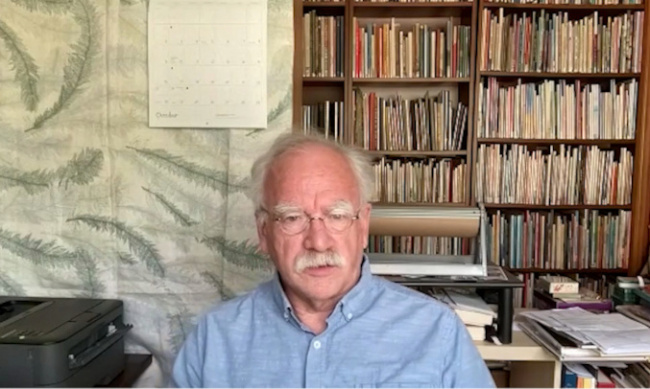
Comics in the 1960s, Including Some of the First Comic Stores
Posted by Dan Gearino on May 26, 2023 @ 6:16 am CT
MORE COMICS
Shop Talk, July 2025
July 25, 2025
All this and more in this month's edition of Shop Talk, our roundup of retailer news.
In Which Jean Grey Survives the Dark Phoenix Saga
July 25, 2025
What If…? Jean Grey survived the end of the Dark Phoenix saga?
MORE NEWS
Supplementary Booster Set for the Guardian Class
July 25, 2025
Legend Story Studios will release Mastery Pack Guardian, a supplementary booster set for Flesh and Blood TCG, into retail.
By Modiphius Entertainment
July 25, 2025
Modiphius Entertainment announced two new Doom board games.



